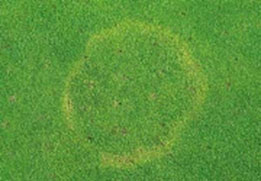Brown Patch
Introduction
Brown patch is a fungal disease that becomes active in late spring and summer when high daily temperatures and high relative humidity start to combine. The fine fescues and bent grass species are most susceptible however the warm season grasses may also be attacked. Cool season species tend to be more vulnerable through midsummer while the warm season species suffer more in spring and late summer through to autumn.

Interestingly, multiple species of Rhizoctonia tend to complement each other to extend the time of year the pathogen is active and broaden the host range and part of the grass plant that is affected.. As a consequence, there are differences in the effectiveness of chemical control options. Unfortunately, determining which species is causing the problem can be difficult and time consuming. Further complicating matters is the difference in appearance of the disease on closely mown and higher cut turf grasses.
Biology
The primary causal agent of brown patch is Rhizoctonia solani with R. cerealis, R. zeae and R. oryzae adding to the disease complex. Rhizoctonia is a soil borne fungus, surviving extended periods living saprophytically on dead and decaying organic matter. The pathogen quickly becomes active when warmth, moisture and a susceptible host is available. This fungus has the ability to remain in a state of suspended animation, not growing but not dead, just waiting for conditions to improve. It can remain in this state for years if necessary without losing viability.
Conditions favouring disease expression
The most conducive conditions for disease occur when relative humidity is greater than 95%, there is rain or added moisture, warm nights, warm to hot days and soil temperatures have moved above approximately 18°C. Other factors implicated in disease prevalence are thatch accumulation, excess nitrogen, poor drainage and allowing dew to remain on the leaf for extended periods.
Visual symptoms
On finer turf that is more closely mown, affected areas may appear regular with a noticeable smoke ring around the perimeter. This smoke ring is generally a grey / purple colour and most noticeable in the mornings when dew is present. Upon drying, the area turns a tan / brown colour. This smoke ring is typical of this disease and may help differentiate this from other fungal diseases. It is common for these rings to appear quickly and develop rapidly. Turf that is cut higher, will present with patchy discoloured areas that look less well defined. The turf may appear thinning and in need of water. Sometimes a green centre of seemingly unaffected blades sits within the circular damaged and discoloured areas. In turf that is not high in health to begin with the symptoms may not show an obvious pattern and may look to be generally under-performing lacking resilience to environmental stresses. It is important that such symptoms are not quickly dismissed as an end of season or start of season anomaly.
Distribution
Found in all states of Australia.
Download PDF